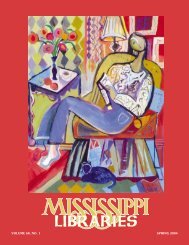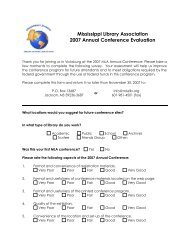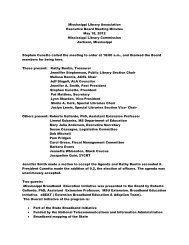Full Text (PDF) - Mississippi Library Association
Full Text (PDF) - Mississippi Library Association
Full Text (PDF) - Mississippi Library Association
You also want an ePaper? Increase the reach of your titles
YUMPU automatically turns print PDFs into web optimized ePapers that Google loves.
Page 2 Vol. 75, No. 1, Spring 2012 <strong>Mississippi</strong> Libraries<br />
Back to School with Information Literacy:<br />
One <strong>Library</strong>’s Plan<br />
Mantra Henderson and Lynn Varner<br />
Abstract<br />
The intention of this article is to<br />
describe why and how the James H.<br />
White <strong>Library</strong> plans to integrate an information<br />
literacy program with embedded<br />
assessment into the academic curriculum<br />
at <strong>Mississippi</strong> Valley State University<br />
(MVSU). It is not meant to be a blueprint<br />
or standard on how to implement an<br />
information literacy program. It will, however,<br />
focus on how and why the library<br />
plans to implement their information literacy<br />
program by providing a definition of<br />
information literacy and discussing the<br />
information literacy standards for higher<br />
education, the history of information literacy<br />
at the James H. White <strong>Library</strong>, and<br />
the library’s information literacy program.<br />
Introduction<br />
Academic libraries and librarians suggest<br />
that the primary function of an academic<br />
library has a significant impact on<br />
the educational value of fulfilling a student’s<br />
academic experience and on the<br />
mission and goals of a university. Knowing<br />
how to use a library can provide students<br />
with a sense of confidence in learning, and<br />
provide them with a concrete foundation<br />
for retaining knowledge and transferring<br />
learning from one experience to another<br />
(Rockman 2002). Thus, to emphasize the<br />
importance of the James H. White<br />
<strong>Library</strong>’s role to MVSU’s mission and<br />
goals, the library staff developed an information<br />
literacy program with embedded<br />
Mantra L. Henderson is the director of James<br />
H. White <strong>Library</strong> at <strong>Mississippi</strong> Valley State<br />
University and a doctoral student at Delta State<br />
University. Dr. Lynn Varner is an associate<br />
professor of educational leadership and<br />
research at Delta State University. Correspondence<br />
concerning this article may be sent to<br />
mlhenderson@mvsu.edu.<br />
assessment. This article focuses on the<br />
library’s plans to implement the information<br />
literacy program by providing a definition<br />
of information literacy and discussing<br />
information literacy standards for higher<br />
education, the history of information literacy<br />
at the James H. White <strong>Library</strong>, and the<br />
library’s information literacy program.<br />
What is Information Literacy<br />
The <strong>Association</strong> of College and<br />
Research Libraries (ACRL) states that information<br />
literacy is a group of skills that<br />
make it possible for individuals to have the<br />
ability to find, critically analyze, and effectively<br />
use information and to know when<br />
that information is needed. However, information<br />
literacy includes more than just<br />
library skills. It also includes media and<br />
technology literacy. Consequently, information<br />
literacy works best when implemented<br />
across an academic curriculum<br />
through collaborative efforts of both librarians<br />
and university faculty.<br />
Information Literacy Standards<br />
The James H. White <strong>Library</strong> utilizes<br />
ACRL’s Information Literacy Competency<br />
Standards for Higher Education (2000) as<br />
the basis for assessing the information literacy<br />
skills of an individual. The standards<br />
are utilized to determine whether an information<br />
literate MVSU student is able to:<br />
determine the extent of information<br />
needed,<br />
access the needed information effectively<br />
and efficiently,<br />
evaluate information and its sources<br />
critically,<br />
use information effectively to accomplish<br />
a specific purpose,<br />
understand the economic, legal, and<br />
social issues surrounding the use of<br />
information, and<br />
access and use information ethically<br />
and legally.<br />
History of Information Literacy<br />
Instruction at James H. White<br />
<strong>Library</strong><br />
Bibliographic instruction has always<br />
been the primary methodology utilized by<br />
the James H. White <strong>Library</strong> to convey<br />
library skills to students of MVSU. This<br />
was done primarily via instruction at the<br />
reference desk, one-to-one librarian consultations,<br />
and library tours. In 2001, the<br />
library established a User Access Education<br />
Program. The James H. White <strong>Library</strong><br />
has many resources, tools, and services<br />
that are helpful in completing assignments<br />
and conducting research. Many of these<br />
print and electronic sources are arranged<br />
and used differently; therefore they can be<br />
intimidating to the unfamiliar user or anyone<br />
who has not received proper or formal<br />
instruction. Both graduate and undergraduate<br />
students at MVSU are introduced to<br />
various research sources through User<br />
Access instruction sessions. These sessions<br />
are arranged by faculty to enhance<br />
the instruction they provide in the classroom.<br />
University faculty members are encouraged<br />
to schedule a user access session by<br />
contacting the Reference Department. The<br />
librarians, in conjunction with the Reference<br />
Department, will develop a session to<br />
accommodate the students’ research<br />
needs based on the information given by<br />
the course instructor. The James H. White<br />
<strong>Library</strong> offers three levels of library instruction:<br />
basic introduction to the library, information<br />
literacy, and research 101. Basic<br />
introduction is designed to introduce students<br />
to the James H. White <strong>Library</strong> and its<br />
resources. The information literacy level is<br />
designed to empower students to determine<br />
the nature and extent of information<br />
needed. Research 101 is designed to provide<br />
guidance in the preparation of short<br />
and long research papers and other forms<br />
of writing. This level may also require critical<br />
evaluation of journals, books, and<br />
Internet resources, assistance with the cor-














